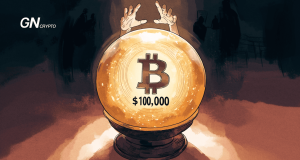Ethereum: Does It Have Intrinsic Value?

Ethereum is one of the most popular cryptocurrencies in the market. Launched in 2015 by Vitalik Buterin and Joseph Lubin, this decentralized, open-source blockchain coin hit its all-time high on Nov. 16, 2021 when it traded at $4,891.70
On this page
With the coin now sitting at just over $2,900, the talk of whether Ethereum has intrinsic value – a financial term that refers to the perceived or actual value of an asset or a currency – rattles on.
So, how come it is possible for something that exists online only to have intrinsic value?
While ETH and all other cryptocurrencies are yet to be perceived as truly valuable by a vast majority of the population, it does not mean that they are void of value. More so since dollars, euros, and all other currencies are pieces of paper, though highly-protected ones and issued by authorities like central banks.
They are valuable only because we assign value to them. We use them for purchasing goods and paying for services because we decided that these pieces of paper are more than a chunk of processed, flattened, and colored trees.
But in many different situations, money loses its value – whether because of major financial meltdowns that sometimes result in defaults or wars when money often buys you nothing. This renders its use cases non-existent – and without use cases no coin, either physical or digital, means much.
Because of the rise of decentralized finance, decentralized application, non-fungible tokens, and web3, ETH, like many other cryptocurrencies, is acquiring use cases and technological applications, – which means they are gaining some sort of value.
ETH’s main use case is it could facilitate programmatic smart contracts and applications using it. Smart contracts, powered by ERC-20, enable peer-to-peer execution agreements. This means that no third-party, such as banks or legal institutions, have to intervene to give its “blessing” as the procedure is automatically done on the blockchain.
Since billions of dollars are already being used for payments, loans, insurance, and any DeFi application, ETH has a good chance of becoming a go-to coin for making payments faster and easier.
According to some observers, it is also slated to “change the way financial and public services are managed including categories like governance, supply chains, markets, and digital identification”.
Marc Cuban, an avid ETH fan, has likewise emphasized that “I can see an unlimited number of applications that will change the biz/consumer world forever. And to use them you need to buy Eth … BTC doesn’t have that demand pull.”
Ethereum has also proved to be resilient to fierce competition from other tokens with similar goals. For example, Tron, which ERC-20 effectively trumps, as it underpins the highest number of DeFi projects, NFTs, and tokens.
With ETH looking to increase its scalability by transitioning to ETH 2.0 and shifting from the cumbersome proof-of-work to proof-of-stake, it will likely continue to increase the efficiency and speed of blockchain transactions. As well as its intrinsic value, which is certainly there.
The content on The Coinomist is for informational purposes only and should not be interpreted as financial advice. While we strive to provide accurate and up-to-date information, we do not guarantee the accuracy, completeness, or reliability of any content. Neither we accept liability for any errors or omissions in the information provided or for any financial losses incurred as a result of relying on this information. Actions based on this content are at your own risk. Always do your own research and consult a professional. See our Terms, Privacy Policy, and Disclaimers for more details.

























